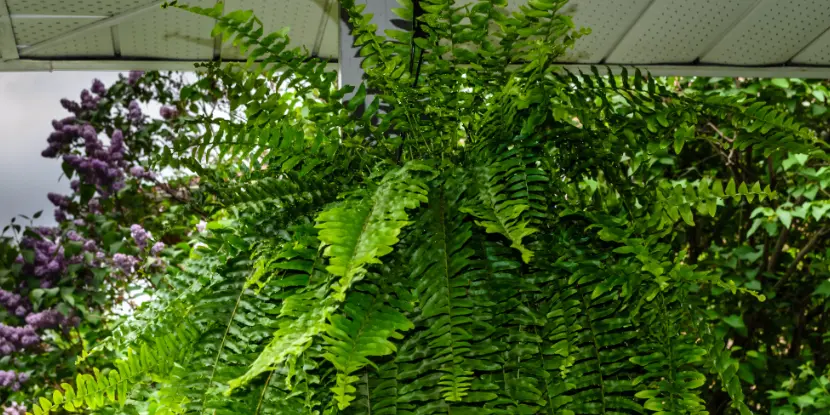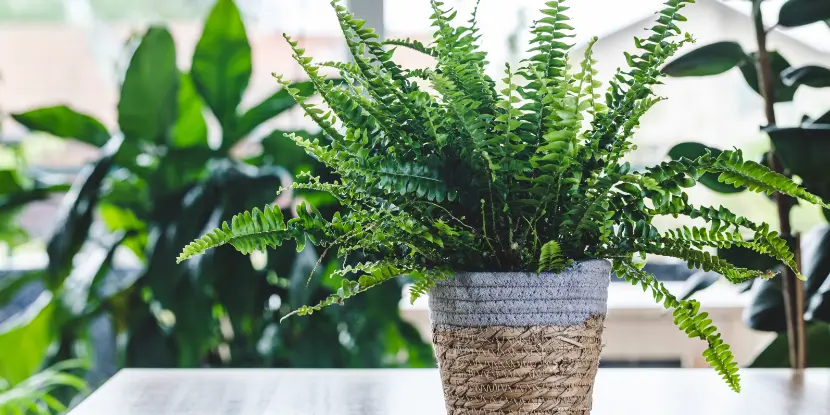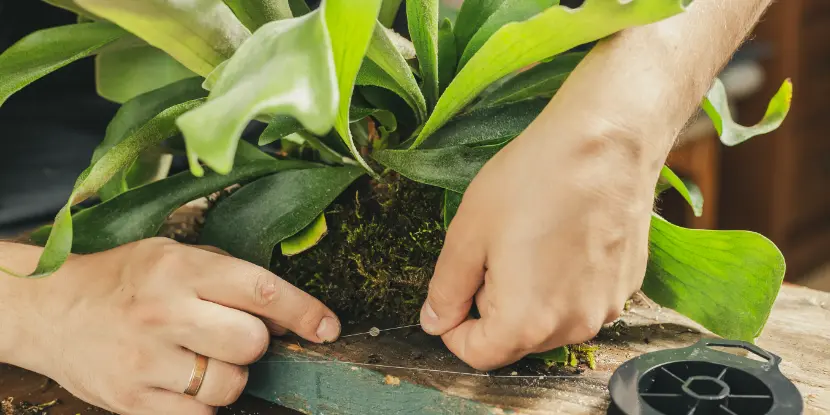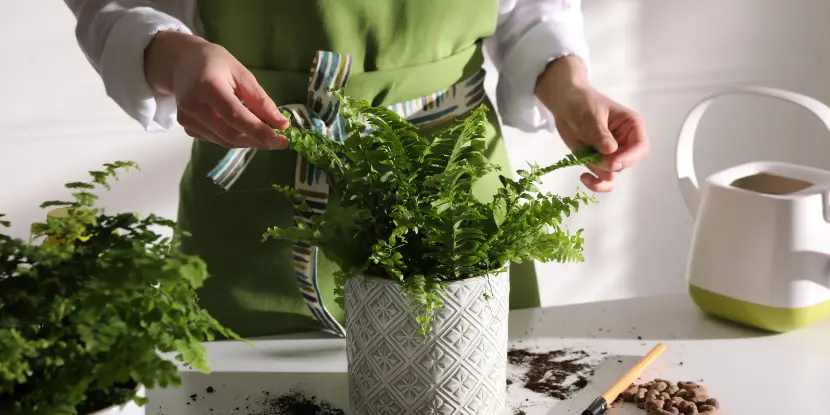Ferns are special plants. Fossil records show they date back to the Paleozoic era, 400 million years ago.
They’ve existed for millions of years and have adapted to nearly every climate and environment on Earth. They flourish in alpine areas and deserts, ponds and lakes, on the ground and high in trees, and in temperate and tropical climates.
They can also flourish in your home.
Some plant lovers shy away from ferns, considering them hard to grow. But fern care can be simple if you follow a few basic guidelines.

A magnificent hanging Boston fern.
How Humidity Affects Indoor Ferns
Ferns must have humidity, which is usually lacking in modern homes.
- To humidify your ferns, half fill a saucer or tray with gravel. Let the plant pot sit on top of the gravel.
- Keep a little water in the gravel at all times, but don’t let the water level reach high enough to touch the bottom of the pot.
- If your potted fern grows in a decorative planter, you can stuff moist sphagnum moss between the pots and moisten it as needed.
Temperature
- Ferns are hardy plants that thrive in temperatures between 65°F (18°C) and 75°F (24°C).
- They can tolerate slightly cooler temperatures, but may not grow as quickly.
- Keep ferns away from drafts and air conditioning or heating vents, which can dry them out.
Light & Ferns
Although we associate ferns with shady gardens, they still need adequate light indoors.
- Indoor ferns grow best in bright, indirect light. Avoid direct sunlight.
- Place your ferns in bright windows. A window with an eastern exposure is best; sheer curtains can veil south and west windows for fern culture.
- Don’t move your plants too far from these windows (no more than 2 to 3 feet away), as this reduces the light significantly.

A healthy young Boston fern.
Watering Ferns
- If possible, use distilled or rainwater. If you must use tap water, let it stand for a few hours before applying.
- Don’t pour water over the fern foliage. This applies to ferns in hanging baskets, as well.
- Don’t let water touch the foliage if you water your hanging basket fern by immersing it in water.
- Fern baskets hanging outside should be in complete shade, protected from wind.
- Good drainage is crucial because the soil should be kept moist.
Fertilizing Ferns
- Potted ferns should be fed monthly from March to October.
- Ferns growing in hanging baskets should be fed every two weeks.
- Organic fertilizers, fish emulsion being one of the best, won’t burn your ferns. Water-soluble fertilizers also give superior results if you precisely follow the manufacturer’s directions.
- Fertilizer burns are more likely to occur with ferns in hanging baskets because the roots are close to the fertilizer granules. Dilute the fertilizer and apply it to the soil, not the foliage.

Closeup of young fern sprout.
Pest & Disease Control
Ferns can fall victim to a variety of pests and diseases. Here are some common issues and their solutions:
Pests
- Scale Insects: Wipe the leaves with a cotton swab dipped in rubbing alcohol or use insecticidal soap. Isolate affected plants to prevent spreading.
- Aphids: Spray the ferns with a mixture of water and a few drops of dish soap. Ladybugs are also natural predators of aphids and can be introduced to the environment if feasible.
- Mealybugs: To remove mealybugs from the leaves, use a cotton swab dipped in rubbing alcohol. To prevent infestations, regularly inspect and clean the plants.
- Spider Mites: Increase humidity around the ferns and rinse the leaves with water. In severe cases, use an insecticidal soap or neem oil spray.
Diseases
- Root Rot: Ensure the soil has good drainage and avoid overwatering. Remove affected parts of the plant and replant in fresh, sterile soil if necessary.
- Leaf Spot: Remove and dispose of affected leaves to prevent the spread. Apply a fungicide suitable for ferns and increase air circulation around the plant.
- Botrytis (Gray Mold): Remove infected parts immediately and avoid overhead watering. Use a fungicide if the problem persists, and ensure adequate ventilation.
Soil
Ferns are grouped by their natural habitat. We classify them as epiphytic (growing in trees), terrestrial (growing in soil), or aquatic (growing in water).
Epiphytic Ferns
Epiphytic ferns need coarse soil that allows fast and thorough drainage. It should be rich in organic leaf mold, sphagnum moss, or peat moss.
With the proper soil mix, epiphytic ferns can be planted in hanging baskets or pots. They can also be mounted on logs, slabs, plaques, or mats.
Staghorn and the Polypodium “footed ferns” are examples of epiphytic ferns.

Mounting a staghorn fern.
Terrestrial Ferns
Terrestrial ferns, the largest group of ferns, will grow in normal potting soils. Their mix should contain peat moss, perlite for added drainage, and maybe sand for added weight.
Terrestrial ferns can be planted in hanging baskets, pots, or tubs.
Boston ferns and their many varieties and Maidenhair ferns are examples of terrestrial ferns.
Aquatic Ferns
Aquatic ferns are usually found floating in or at the edges of ponds and lakes. They’re suitable for outdoor koi ponds, aquaria, and patio container water gardens.
The water clover, Marsilea Quadrifolia, is a good example of an aquatic fern that can adapt to soil. The widespread mosquito fern, Azolla caroliniana, which sometimes covers hundreds of square feet as a single colony, is an example of a free-floating water fern.

Repotting a Boston fern.
Re-potting & Dividing Ferns
Ferns need repotting every one to three years, depending on the size of the pot and the rate at which your fern grows.
Ferns also benefit from division every three to five years. You can do this in the spring or fall.
- To re-pot, remove the fern from its pot, shake away excess soil, and cut away any dead or damaged roots with a sharp knife, taking care not to injure the crown.
- Replant it in a slightly larger pot than the original one.
- Add soil and press it firmly around the roots.
- Water thoroughly after re-potting.
The best time for division is early spring, when new growth begins. Always use sterile potting mix when repotting or dividing ferns.
FAQs: Fern Care Indoors
Q: How often should I water my indoor ferns?
Water your indoor ferns once the top inch of soil feels dry to the touch, usually once or twice a week. This can vary depending on the humidity and temperature of your home.
Q: Do indoor ferns need direct sunlight?
Indoor ferns prefer indirect light. Place them near a window with morning sunlight or filtered light throughout the day. Direct sunlight can scorch their leaves.
Q: What is the best way to maintain humidity for indoor ferns?
Mist the leaves regularly, place a humidifier nearby, or set the fern’s pot on a tray filled with pebbles and water to increase humidity.
Q: What type of soil is best for indoor ferns?
A light, well-draining potting mix is best. Try a mix designed explicitly for ferns, or make your own by blending peat moss, perlite, and vermiculite.
Q: How do I know if my fern is too dry?
If the leaves of your fern turn brown and crispy, it’s likely too dry. Increase watering frequency and consider boosting humidity around the plant.
Q: How often should I fertilize my indoor ferns?
A: Fertilize indoor ferns during the growing season (spring and summer) with a balanced, water-soluble fertilizer, diluted to half the recommended strength, once a month.
Q: How can I propagate my indoor fern?
You can propagate ferns by division. Gently separate a portion of the plant, ensuring it has roots, and pot it in a similar soil mix. Keep it in a warm, humid spot until it establishes.
Q: Why are the fronds of my fern turning yellow?
Yellowing fronds can be a sign of overwatering or poor drainage. Make sure your fern’s pot has drainage holes and the soil is not waterlogged.
Q: How often should I repot my indoor fern?
It’s generally best to repot indoor ferns every 2–3 years or when you notice roots coming out of the drainage holes. Springtime is the ideal period for repotting.
Q: Are indoor ferns pet-friendly?
Most fern species are non-toxic and safe for pets. However, it’s always a good idea to check the specific type of fern, as there are exceptions.

